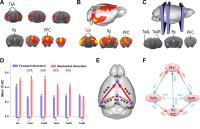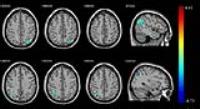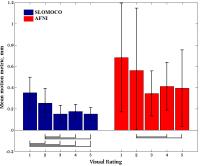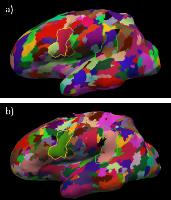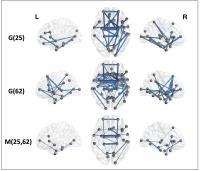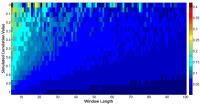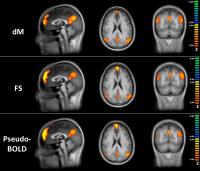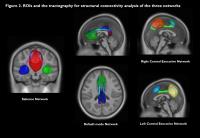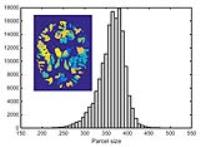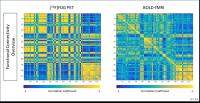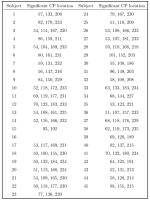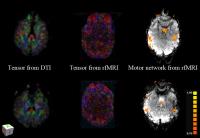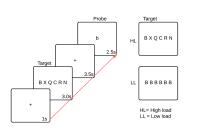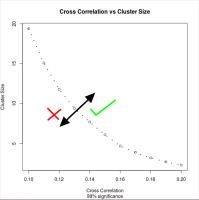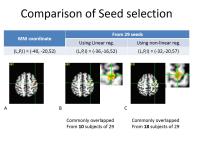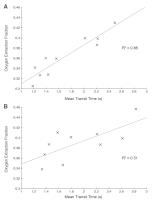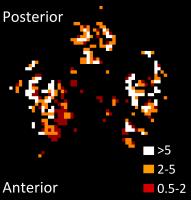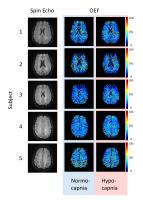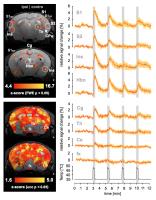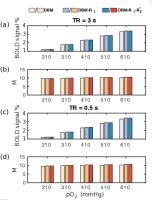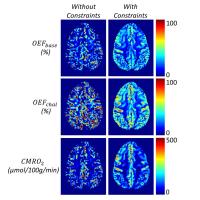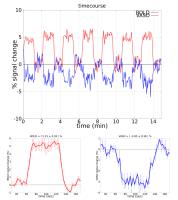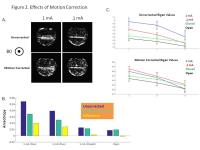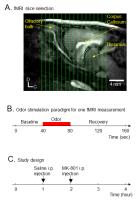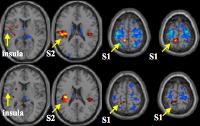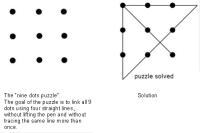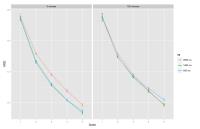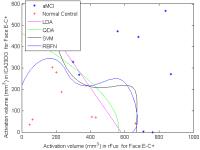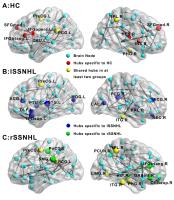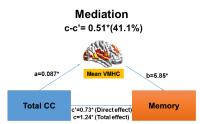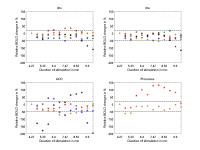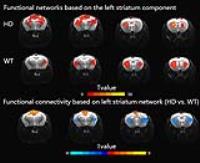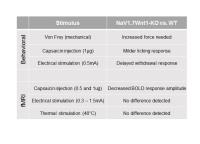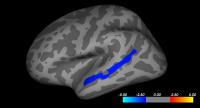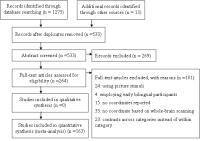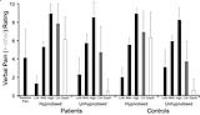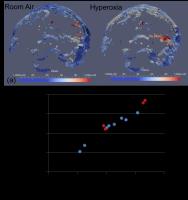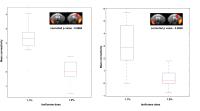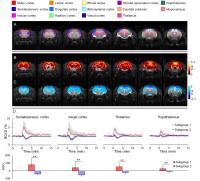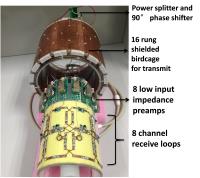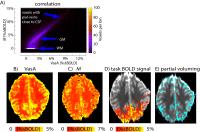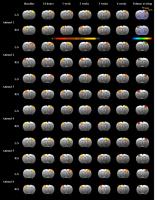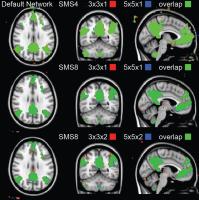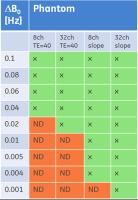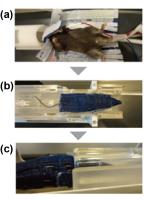|
1669.
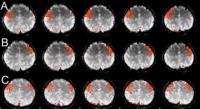 |
Investigation of functional baseline neuronal specificity and
small-scale network in human primary motor cortex at 7T
Chan Hong Moon1, Jung-Hwan Kim1,2, and
Kyongtae Ty Bae1,2
1Radiology, University of Pittsburgh, Pittsburgh,
PA, United States, 2Bioengineering,
University of Pittsburgh, Pittsburgh, PA, United States
Compound signal, BOLD (e.g., de-oxygenation, CBF and CBV)
has different neuronal specificity depending on the major
source. At high-field such as 7T, stimulus-evoked BOLD (fMRI)
is known to be more localized to cortex region mainly due to
suppression of short T2* signals in large draining vessels.
It is question whether spontaneous-evoked BOLD during
resting status (rsfMRI) can be localized to neural response
and the correlation with fMRI activation. In this study, we
investigated BOLD source during resting status in primary
motor cortex using high-resolution 7T, and additionally the
advantage of 7T rsfMRI in small-scale brain connectivity.
|
|
1670.
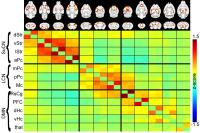 |
Dynamic reorganization of intrinsic functional networks in the
mouse brain 
Joanes Grandjean1, Maria G. Preti 2,3,
Thomas AW Bolton2, Dimitri Van De Ville2,
and Markus Rudin4
1ETH and University Zurich, Zurich, Switzerland, 2EPFL,
Lausanne, Switzerland, 3University
of Geneva, Geneva, Switzerland, 4University
and ETH Zurich, Zurich, Switzerland
Dynamic functional connectivity was assessed in the mouse
brain. High quality resting-state fMRI data were acquired
and analysed with sliding window correlations. Re-occurring
dynamic functional networks were estimated using dictionary
learning from the sliding window correlation matrix. The
dynamic functional connectivity analysis reveals rich
patterns of interactions, which were absent in the standard
static functional connectivity analysis, and may be used to
describe specific alterations in mouse models of brain
disorders. In particular, the dynamic functional networks
present salient features such as between and within module
interactions, which complement the static functional
connectivity analysis.
|
|
1671.
 |
Visual Stimulation Altered Human Visual Cortical Functional
Connectivity 
Jie Huang1 and
David C Zhu2
1Department of Radiology, Michigan State
University, East Lansing, MI, United States, 2Departments
of Radiology and Psychology, Michigan State University, East
Lansing, MI, United States
Areas across the visual cortex are functionally connected.
Certain patterns can induce perceptual illusions/distortions
and visual discomfort in most people, headaches in patients
with migraine, and seizures in patients with photosensitive
epilepsy. This preliminary study investigated visual
stimulation effect on human visual cortical functional
connectivity (FC). The study found that a 25-min visual
stimulation with a stressful pattern significantly enhanced
the FC within the visual cortex and altered the FC to V1 in
other regions too, with a lasting effect even after the
cessation of the stimulation.
|
|
1672.
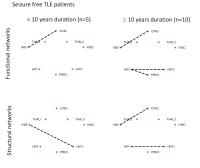 |
Similarity in structural and functional network connectivity
evolution over duration of TLE 
Victoria L. Morgan1, Ahmet Cakir2,
Benjamin N. Conrad1, Bassel Abou-Khalil3,
Adam W. Anderson1,4, Zhaohua Ding1,
and Bennett A. Landman1,2
1Institute of Imaging Science, Vanderbilt
University, Nashville, TN, United States, 2Electrical
Engineering and Computer Science, Vanderbilt University,
Nashville, TN, United States, 3Neurology,
Vanderbilt University, Nashville, TN, United States, 4Biomedical
Engineering, Vanderbilt University, Nashville, TN, United
States
Temporal lobe epilepsy (TLE) is a common and relatively
homogeneous form of epilepsy in which seizures originate in
the mesial temporal regions including the hippocampus and
propagate across the brain. This work represents the first
step in characterizing the functional (FC) structural (SC)
network connectivity evolution in TLE using MRI. We found
consistent decreases in ipsilateral hippocampus and insula
FC and SC primarily after 10 years of duration of disease in
patients with seizure freedom after surgery. In those with
seizure recurrence, there were more severe bilateral
hippocampal SC decreases when compared to those with seizure
freedom.
|
|
1673.
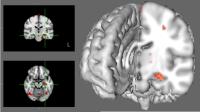 |
Gender related peculiarities of amygdala deactivation during
movements
Oleksii Omelchenko1, Zinayida Rozhkova2,
and Mykola Makarchuk1
1Human and Animal Physiology, Taras Shevchenko
National University of Kyiv, Kyiv, Ukraine, 2Medical
Clinic BORIS, Kyiv, Ukraine
Men and women might display distinct characteristics of
functional organization of neurocognitive brain networks.
Considering gender-specific brain functioning under
language, emotional and memory tasks execution, we propose
fMRI visualization of the brain activated by a movement task
for estimation of gender specific motor brain network
peculiarities. New evidence for gender related differences
in amygdala function was found. Results also give us
background for further subdivision of the fMRI normative
basis from which we investigate functional brain changes in
patients’ population.
|
|
1674.
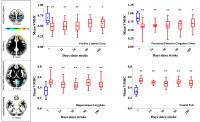 |
Longitudinal Study of Motor Recovery After Pontine Infarction
with Resting-state fMRI:A Homotopic Connectivity Study
Yi Shan1, Chaogan Yan2, Miao Zhang1,
Dongdong Rong1, Zhilian Zhao1,
Qingfeng Ma3, Xinian Zuo2, Jie Lu4,
and Kuncheng Li1
1Department of Radiology, Xuanwu hospital,
Capital Medical University, Beijing, China, People's
Republic of, 2Key
Laboratory of Behavioral Science and Magnetic Resonance
Imaging Research Center, Institute of Psychology, Chinese
Academy of Sciences, Beijing, China, People's Republic of, 3Department
of Neurology, Xuanwu hospital, Capital Medical University,
Beijing, China, People's Republic of, 4Department
of Nuclear Medicine, Xuanwu hospital, Capital Medical
University, Beijing, China, People's Republic of
Impairment of motor function is one of the most severe
deficit in ischemic stroke patients. Therefore, evaluations
of brain function reorganization during spontaneous motor
recovery are extremely valuable. In the present study, we
used a voxel-mirrored homotopic connectivity (VMHC) method
to investigate the longitudinal functional homotopic changes
in patients with pontine infarction during a 180-day-period
follow-up. The result shows resting-state fMRI could
demonstrate dynamic whole-brain homotopic FC changes in
stroke patients which might be helpful to further discuss
brain reorganization after stroke. Also, VMHC between
cognitive brain areas in acute stage had significant
correlation with clinical behavioral performance in chronic
period which might be meaningful in predicting motor
outcome.
|
|
1675.
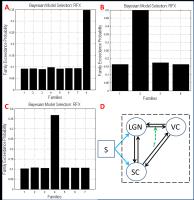 |
Exploring visual network connectivity in the mouse brain using
DCM fMRI
Arun Niranjan1, Peter Zeidman2, Jack A
Wells1, and Mark F Lythgoe1
1Centre for Advanced Biomedical Imaging,
University College London, London, United Kingdom, 2Institute
of Neurology, University College London, London, United
Kingdom
Understanding effective (i.e. causal) connectivity in the
brain using fMRI with dynamic causal modelling (DCM) has
attracted a large amount of interest in recent years.
Applications of fMRI to map brain function in the mouse are
on the rise, targeting transgenic mouse models of pathology.
However, DCM has not yet been applied to mouse brain fMRI,
in part due to the difficulties of acquiring high quality
data. In this work we demonstrate the use of DCM fMRI to
understand effective connectivity in the healthy mouse
visual system, showing results consistent with the
underlying biology.
|
|
1676.
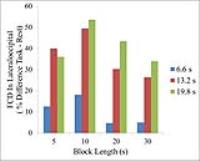 |
Task-related dynamic functional connectivity in fast fMRI 
Ashish Kaul Sahib1, Michael Erb1,
Klaus Scheffler2, Thomas Ethofer1, and
Niels Focke3
1Biomedical magnetic resonance, University of
tuebingen, Tuebingen, Germany, 2Max-Planck-Institute
for Biological Cybernetics, Tuebingen, Germany, 3Department
of Neurology/Epileptology, University of tuebingen,
Tuebingen, Germany
Recent advances in simultaneous multi-slice imaging have
improved the temporal resolution of fMRI. Using a sliding
window approach we aimed to capture the dynamic network
changes that occur during visual stimulation. We estimated
the functional connectivity degree (FCD) at various
stimulation lengths and window sizes. We demonstrate that
the analysis of dynamic functional connectivity using a
sliding window approach is an effective technique to capture
whole brain temporal dynamics during a simple block-designed
visual experiment (checkerboards). In summary, for the
current setup, a window size of 13.s provided an optimum
trade-off between temporal smoothness and FCD estimation.
|
|
1677.
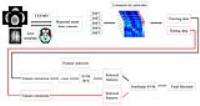 |
CEEMD-based Multi-Spectrum Brain Networks for Identification of
MCI 
Li Zheng1, Long Qian1, Dandan Zheng2,
and Jiahong Gao3,4
1Department of Biomedical Engineering, College of
Engineering, Peking University, Beijing, China, People's
Republic of, 2GE
Healthcare, MR Research China, Beijing, Beijing, China,
People's Republic of, 3Beijing
City Key Lab for Medical Physics and Engineering, Institute
of Heavy Ion Physics, School of Physics, Peking University,
Beijing, China, People's Republic of, 4Center
for MRI Research, Academy for Advanced Interdisciplinary
Studies, Peking University, Beijing, China, People's
Republic of
The early detection of MCI is of paramount importance for
possible delay of the transition from MCI to AD. Recently,
several resting-state fMRI based neural imaging studies have
been applied for MCI diagnosis by the aid of pattern
classification recently. In current study, CEEMD-based
high-dimensional pattern classification framework was
proposed to identify MCI individuals from subjects who
experience normal aging with an accuracy of 93.3 percent,
compared to conventional method for brain oscillation
separation. In addition, the most discriminant regions
selected by our method also reflected the association with
MCI, to some degree.
|
|
1678.
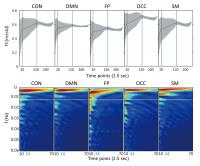 |
Age related fluctuation energy and variation of dynamic
functional connectivity
Yuanyuan Chen1, Weiwei Wang1, Xin Zhao1,
Miao Sha1, Yanan Liu1, Peng Zhou1,
Hongyan Ni2, and Dong Ming1
1Tianjin University, Tianjin, China, People's
Republic of, 2Tianjin
First Central Hospital, Tianjin, China, People's Republic of
To reveal the age related changes of dynamic function
connectivity during rest, five networks were extracted from
resting stated fMRI data of 36 young people and 32 old
people. The sliding window was carefully selected and the FC
variation and the fluctuation energy in detailed frequency
band were statistically compared. Decreased FCV and slowing
fluctuation in inter-networks were mainly found in old
group. OCC and CON, OCC and FP were the most consistent
inter-networks between this two age related changes. We
concluded that FCV and fluctuation energy had provided a new
perspective of aging research.
|
|
1679.
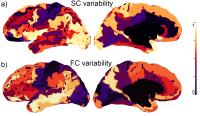 |
Association between structural and functional inter-subject
variability of the motor and visual networks 
Maxime Chamberland1,2, Gabriel Girard2,
Michaël Bernier1, Michael Paquette2,
David Fortin3, Maxime Descoteaux2, and
Kevin Whittingstall1,4
1Nuclear Medicine and Radiobiology, Université de
Sherbrooke, Sherbrooke, QC, Canada, 2Computer
science, Université de Sherbrooke, Sherbrooke, QC, Canada, 3Division
of Neurosurgery and Neuro-Oncology, Université de Sherbrooke,
Sherbrooke, QC, Canada, 4Department
of Diagnostic Radiology, Université de Sherbrooke,
Sherbrooke, QC, Canada
"Your brain is unique" is an unequivocal sentence
that has spanned many research topics in the recent years.
For example, functional connectivity (FC) based on
resting-state fMRI is highly variable from one subject to
the next, yet the source of this variability is unclear.
Understanding the source of FC variability is important as
it is often used in clinical studies. Here, we explore how
this might be explained by variability of white-matter
structural connectivity (SC) derived from diffusion MRI
tractography connectivity matrices. Our results show that,
across multiple brain areas, motor and visual networks show
the lowest inter-subject variability. This suggests that, at
least in these areas, SC might explain a portion of FC
variability.
|
|
1680.
 |
Interhemispheric Functional Connectivity Modulated by Menstrual
Cycle
Xinyuan Miao1, Lin Shi1, Yan Zhuo2,
and Yihong Yang3
1Department of Medicine and Therapeutics, Chinese
University of Hong Kong, Hong Kong, Hong Kong, 2Institute
of Biophysics, Chinese Academy of Sciences, Beijing, China,
People's Republic of, 3National
Institute on Drug Abuse, NIH, Baltimore, MD, United States
The functional lateralization of the brain was modulated by
the menstrual cycle of women, while the mechanism of which
still need to investigate.In this study, we used
interhemispheric functional connectivity of the
resting-state functional MRI to investigate changes in the
symmetrical interhemispheric correlations in women’s
different menstrual phases. Our results showed that the
brainstem and cerebellum had significantly higher
interhemispheric correlations in the early follicular phase
than in the mid-luteal phase.
|
|
1681.
 |
Combining Resting-State fMRI and Perfusion maps for potential
Pre-Surgical Planning
Lalit Gupta1, Prativa Sahoo1, Pradeep
K Gupta2, Indrajit Saha3, Rana Patir4,
Sandeep Vaishya4, and Rakesh K Gupta2
1Philips India Ltd., Bangalore, India, 2Department
of Radiology, Fortis Memorial Research Institute, Gurgaon,
India, 3Philips
India Ltd., Gurgaon, India, 4Department
of Neurosurgery, Fortis Memorial Research Institute, Gurgaon,
India
Mapping of functionally active regions for patients with
mass lesions is critical for pre-surgical planning. We have
developed an atlas based approach that automatically select
seed points from six functional regions (motor and language
regions) and computes corresponding functionally connected
regions using resting state fMRI data. Functional
connectivity maps were super-imposed on MR perfusion maps
and structural images. Results were obtained from 22 brain
tumor patients. Regions near the tumor with high correlation
are seen as active regions that contribute to motor/language
activities, combined with perfusion maps may help clinicians
for better surgical planning.
|
|
1682.
 |
Memory and Learning: Visually-evoked Olfactory fMRI Activation
Patterns and its Dynamics
Prasanna Karunanayaka1, Xin Zhang2,
Michael Tobia1, Jianli Wang1, Bin
Zhang2, Bin Zhu 2,
and Qing Yang1
1Radiology, Penn State University, Hershey, PA,
United States, 2The
affiliated Drum Tower hospital of Nanjing university medical
school, Nanjing, China, People's Republic of
Behavioral studies show that human odor perception is highly
dynamic, incorporates both spatial and temporal codes, and
is easily influenced by information from other sensory
systems such as vision. However, the neural representation
of odor perception and its dynamic processing by the brain
is poorly understood. In this research, using olfactory task
fMRI, we attempt to unravel how olfactory-related neural
networks interact in both space and time in order to explore
how the olfactory and the visual systems integrate
information at the central or perceptual levels in the human
brain.
|
|
1683.
 |
Quasi-periodic pattern of fMRI contributes to functional
connectivity and explores difference between Major Depressive
Disorder and control
Kai Wang1, Waqas Majeed2, Garth
Thompson3, Kui Ying4, Yan Zhu5,
and Shella Keilholz6
1Department of Biomedical Engineering, Tsinghua
University, Beijing, China, People's Republic of, 2Department
of Electrical Engineering, LUMS School of Science and
Engineering, Lahore, Pakistan, 3Department
of Radiology and Biomedical Imaging, Yale University, New
Haven, CT, United States, 4Department
of Engineering Physics, Tsinghua University, Beijing, China,
People's Republic of, 5Psychiatry
Department, Yu Quan Hospital, Tsinghua University, Beijing,
China, People's Republic of, 6Department
of Biomedical Engineering, Emory University/Georgia
Institute of Technology, Atlanta, GA, United States
Quasiperiodic pattersn (QPPs) of BOLD fluctuations, first
reported in [1,2] are likely contributors to functional
connectivity (FC) due to their spatial and temporal
structure. FC has been widely used to explore the altered
brain organization in patients suffering from psychological
disorders like Major Depressive Disorder (MDD). In this
project, we examined the contribution of QPPs to FC in both
normal subjects and MDD patients. Results showed that QPPs
are a major contributor to FC, and that QPP abnormality can
be a contributor to or marker of psychiatric or neurological
disorders.
|
|
1684.
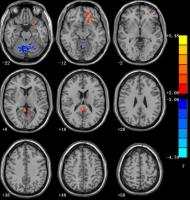 |
Investigation of functional connectivity changes in Alzheimer's
disease and amnestic mild cognitive impairment using Degree
Centrality 
Yong Zhang1, Naying He2, Hua-Wei Lin2,
Ajit Shankaranarayanan3, Zhenyu Zhou1,
and Fu-Hua Yan2
1MR Research China, GE Healthcare, Beijing,
China, People's Republic of, 2Radiology,
Ruijin Hospital, Shanghai Jiaotong University School of
Medicine, Shanghai, China, People's Republic of, 3GE
Healthcare, Menlo Park, CA, United States
This preliminary study investigated functional connectivity
changes in Alzheimer’s Disease (AD) and amnestic mild
cognitive impairment (MCI) using degree centrality (DC), a
novel resting-state fMRI parameter to provide voxel-wise
whole brain functional connectivity measurement. Twelve AD
patients, twelve MCI patients and fifteen healthy controls
were recruited for comparison. As compared to normal
controls, AD patients showed the deceased DC in the
posterior cingulate cortex while MCI patients showed
decreased DC in bilateral cuneus (visual processing) but
increased DC in bilateral hippocampus (memory) and right
angular gyrus (language). The different patterns of FC
changes might provide insight into disease evolvement.
|
|
1685.
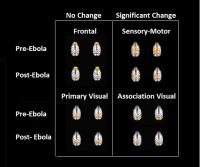 |
Ebola Alters Some, But Not All, Resting-State Intrinsic
Functional Connectivity Networks In The Macaque Brain
Eswar Damaraju1, Margaret Lentz2,
Jeffrey David Lewine1,3, David Thomasson2,
Nadia Biassou4, Anna Honko2, Vince
Calhoun1, and Peter Jahrling2
1Mind Research Network, Albuquerque, NM, United
States, 2Integrated
Research Facility/NIAID, Frederick, MD, United States, 3Lovelace
Family of Companies, Albuquerque, NM, United States, 4NIH
Clinical Center, Bethesda, MD, United States
Ebola has the potential to cause both acute and chronic
compromise of neurological status. To better understand the
relevant neurobiology, a pilot MRI study of infected
macaques was performed. Data indicate that Ebola exposure
leads to acute disruption of some, but not all, intrinsic
connectivity networks, even in the absence of
intraparenchymal lesions. These studies represent the first
non-invasive functional imaging studies of living, Ebola
infected non-human primates.
|
|
1686.
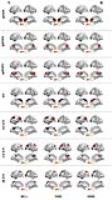 |
Aberrant salience network and its functional coupling with
default and executive networks in minimal hepatic
encephalopathy: a resting-state fMRI study
Hua-Jun Chen1
1The First Affiliated Hospital of Nanjing Medical
University, Nanjing, China, People's Republic of
Aberrant functional coupling of triple network in MHE
|
|
1687.
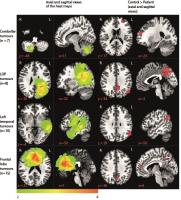 |
Effect of Brain Tumours on the Default Mode Network
Sukhmanjit Ghumman1, David Fortin1,
Stephen Cunnane1, and Kevin Whittingstall1
1Centre Hospitalier Universitaire de Sherbrooke (CHUS),
Sherbrooke, QC, Canada
The effect of various pathologies on the default mode
network (DMN) have been investigated in recent years with
some encouraging results. These studies have found that some
diseases of the nervous system, such as brain tumours, can
have an effect on DMN connectivity. The goal of this novel
research was to investigate whether tumours of certain areas
of the brain or of certain histological type had
disproportionately large effects on the DMN. We believe
that DMN connectivity could be developed into a prognostic
score in the future which might help clinicians in making
key treatment decisions for brain cancer patients.
|
|
1688.
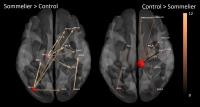 |
Training Induced Olfactory Network Changes in Master Sommeliers:
Connectivity Analysis Using Granger Causality and
Graph-theoretical Approach.
Karthik R Sreenivasan1, Xiaowei Zhuang1,
Virendra Mishra1, Zhengshi Yang1,
Gopikrishna Deshpande2, Sarah Banks1,
and Dietmar Cordes1
1Cleveland Clinic Lou Ruvo Center for Brain
Health, Las Vegas, NV, United States, 2AU
MRI Research Center, Department of Electrical and Computer
Engineering, Auburn University, Auburn, AL, United States
Current study used fMRI to investigate differences in
effective connectivity and network topology between a group
of trained master sommeliers and untrained control
participants during olfactory tasks. Master sommeliers
showed stronger connectivity originating from regions
involved in higher-level cognitive processes than the
controls. There was also increased small-world topology in
the sommeliers. These findings provide unique insights into
the neuroplasticity in adulthood in the olfactory network
which may have added clinical importance in diseases like
Alzheimer’s and Parkinson’s where early neurodegeneration is
isolated to regions important in smell.
|
|
1689.
 |
Structural and Functional Brain Alterations in Uremic restless
legs syndrome patients: A Voxel-Based Morphometry and Functional
Connectivity Study
DUN DING1, PENG LI2, Ji Xin Liu2,
Xue Ying Ma2, and Ming Zhang2
1XI'AN JIAO TONG UNIVERSITY, XI'AN, China,
People's Republic of, 2XI'AN,
China, People's Republic of
To investigate the structure and function changes in the
brain in uremic RLS patients using a resting-state function
magnetic resonance imaging (fMRI) paradigm, we used A voxel-based
morphometry(VBM) method and a seed-based method to find the
abnormiy in end-stage kidney disease patients. Our results
suggest that the characteristics of the connectivity changes
may reflect the pathways involved in producing uremic RLS
symptoms.
|
|
1690.
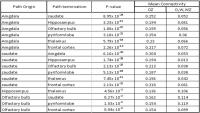 |
Zinc Nanoparticles Enhance Brain Connectivity in the Canine
Olfactory Network: Evidence from an fMRI Study in Fully
Unrestrained Conscious Dogs 
Bhavitha Ramaiahgari1, Oleg M Pustovyy2,
Paul Waggoner3, Ronald J Beyers1, John
Schumacher4, Chester Wildey5, Edward
Morrison2, Nouha Salibi1,6, Thomas S
Denney1,7,8, Vitaly J Vodyanoy2, and
Gopikrishna Deshpande1,7,8
1Dept of Electrical & Computer Engr, AU MRI
research center, Auburn University, Auburn, AL, United
States, 2Dept.
of Anatomy, Physiology & Pharmacology, Auburn University,
Auburn, AL, United States, 3Canine
Detection Research Institute, Auburn University, Auburn, AL,
United States, 4Dept.
of Clinical Sciences, Auburn University, Auburn, AL, United
States, 5MRRA
Inc., Euless, TX, United States, 6MR
R&D, Siemens healthcare, Malvern, PA, United States, 7Dept.
of Psychology, Auburn University, Auburn, AL, United States, 8Alabama
Advanced Imaging Consortium, Auburn University and
University of Alabama Birmingham, Birmingham, AL, United
States
There is intense interest in strategies for enhancing
olfaction capabilities of dogs for various applications such
as bomb detection. Prior fMRI studies showed increased
neural activation when zinc nanoparticles were added to the
odorants. In this study, we obtained fMRI data from awake
and unrestrained dogs when they were exposed to odorants
with and without zinc nanoparticles and zinc nanoparticles
alone. We observed that zinc nanoparticles up-regulated
directional brain connectivity in parts of the canine
olfactory network. This provides a mechanistic explanation
for previously reported enhancement in the odor detection
capability of the dogs in the presence of zinc nanoparticles.
|
|
1691.
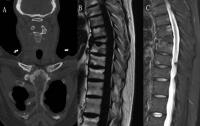 |
Altered amplitude of low-frequency fluctuations and
connectivities in depressed SAPHO syndrome 
Jie Lu1, Yan-ping Duan2, Wen-rui Xu1,
Xue-wei Zhang3, Chen Li4, and Wei-hong
Zhang1
1Department of Radiology, Peking Uinon Medical
College Hospital, Beijing, China, People's Republic of, 2Department
of Psychology, Peking Uinon Medical College Hospital,
Beijing, China, People's Republic of, 3Department
of interventional radiology, China Meitan General Hospital,
Beijing, China, People's Republic of, 4Traditional
Chinese Medicine Department, Peking Uinon Medical College
Hospital, Beijing, China, People's Republic of
To investigate depressed symptoms in SAPHO(Synovitis, acne,
pustulosis, hyperostosis, osteitis ) syndrome and confirm
depression in SAPHO using resting-state functional magnetic
resonance imaging (rs-fMRI). We recruited twenty-four SAPHO
patients and fifteen age- and gender-matched normal controls
(NC). Twelve of the SAPHO patients were diagnosed with
depression. Moreover, depressed SAPHO patients (D-SAPHO)
were proved to have abnormal amplitude of low frequency
fluctuations (ALFF) and functional connectivities (FC)
involved in the regional brain changes which showed
correlated with the severity of depression. These findings
provide crucial information to understand the neural
mechanisms of depressed SAPHO and are helpful to diagnose
depression in SAPHO.
|
|
1692.
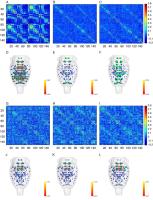 |
Cocaine and the synthetic cathinone MDPV reduce small world
brain network topology: a rat functional connectivity study
Luis Manuel Colon-Perez1 and
Marcelo Febo1
1Psychiatry, University of Florida, Gainesville,
FL, United States
Drug abuse has detrimental effects on the brain function,
which lead to drug use disorders. In vivo non-invasive
biomarkers are needed to determine the neurobiological
outcomes of addictive drugs on the brain. Functional MRI and
graph theory offer an analytical approach to address brain
network changes associated with psychiatric disorders. In
the present study we determined the effects of two addictive
psychostimulant drugs. Comparison between saline and drug
administered shows a reduction in the connectivity at 1 hr
but not at 24 hrs. Acute administration of the two
psychostimulants studied produce only transient effects
lasting at least 1 hr.
|
|
1693.
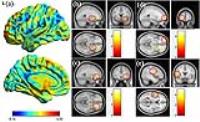 |
Resting-state functional activity and brain network
abnormalities in betel nut chewers
Yu-Syuan Chou1, Ming-Chou Ho2, and
Jun-Cheng Weng1,3
1Department of Medical Imaging and Radiological
Sciences, Chung Shan Medical University, Taichung, Taiwan, 2Department
of Psychology, Chung Shan Medical University, Taichung,
Taiwan, 3Department
of Medical Imaging, Chung Shan Medical University Hospital,
Taichung, Taiwan
Betel nut, also known as areca, is the fourth most commonly
used drug worldwide after tobacco, alcohol, and caffeine and
also a stimulant and addictive substance. Previously, CM
Chen et al. probed into the influence of religious
affiliation on heavy betel nut chewing, and studied on the
relationship between health risk perception and betel nut
chewing. Feng Chen et al. analyzed gray matter abnormalities
between betel nut chewers and healthy subjects with voxel-based
morphometry (VBM). However, there were few studies mentioned
about the functional activity and brain network changes in
betel nut chewers using functional magnetic resonance
imaging (fMRI). Therefore, our aim was to use resting-state
fMRI (rs-fMRI) to investigate the functional differences
between betel nut chewers and healthy participants with
amplitude of low frequency fluctuations (ALFF) and regional
homogeneity (ReHo). The graph theoretical and network-based
statistic (NBS) analyses were also used to find the network
difference between two groups. Our results revealed
different topological organization and poor global
integration of the brain network in the betel nut chewers.
|
|
1694.
 |
Can Cerebral Functional Deficits Be Detected in Patients with Ankylosing Spondylitis?- A Cross-sectional Study
Jun Zhao1, Chuan-Ming Li1, Xin Wei1,
and Jian Wang1
1Radiology, Southwest Hospital, Third Military
Medical University, Chongqing, China, People's Republic of
This study aimed to investigate any cerebral function
deficits in AS(Ankylosing spondylitis) using functional MRI
technology and its possible relationship to clinical and
laboratory results. Compared with normal controls, AS
patients showed widespread brain activity and connectivity
alterations. Functional connectivity strength of the left
precuneus and the left middle temporal gyrus were closely
correlated with the the BASDAI scores, ESR and hsCRP in AS
patients. AS is associated with a altered cortical activity
of rs-fMRI signals. Measurement of functional connectivity
strength of the left precuneus and the left middle temporal
gyrus may aid in the clinical detection and evaluation of AS
|
|
1695.
 |
Functional dysconnection between anterior cingulate cortex and
thalamus in patients with Kleine-Levin syndrome
Ting-Chih Wang1, Yao-Chia Shih2,3,
Hong-Huei Liu4, and Wen-Yih Issac Tseng3,5
1Department of Electrical Engineering, National
Taiwan University, Taipei, Taiwan, 2Institute
of Biomedical Engineering, National Taiwan University,
Taipei, Taiwan, 3Institute
of Medical Device and Imaging, National Taiwan University
College of Medicine, Taipei, Taiwan, 4Department
of Neurology, National Taiwan University Hospital, College
of Medicine, National Taiwan University, Taipei, Taiwan, 5Molecular
Imaging Center, National Taiwan University, Taipei, Taiwan
Kleine-Levin Syndrome is a rare neurological disorder
characterized by recurrent episodes of excessive sleepiness
and other symptoms listed in the ICSD Diagnostic Criteria
for KLS. Its etiology is still unknown nowadays. The most
consistent finding in KLS is abnormal thalamic function.
Here, we used seed-based analysis to analyze resting state
fMRI obtained from 2 patients with KLS. In bilateral
thalamic seeding, both patients showed decreased connection
between the thalamus and the anterior cingulate cortex. This
result could be attributed to alteration of the dorsal
pathway in ascending arousal system, and might also explain
their attention deficits.
|
|
1696.
 |
Pinpointing the rat cerebellar and medullary noxious networks
with fMRI based fcMRI
Rupeng Li1, Xiping Liu2, Jason
Sidabras1, Christopher Pawela3,
Andrzej Jesmanowicz1, and James Hyde1
1Biophysics, Medical College of Wisconsin,
Milwaukee, WI, United States, 2Dermatology,
Medical College of Wisconsin, Milwaukee, WI, United States, 3Anesthesiology,
Medical College of Wisconsin, Milwaukee, WI, United States
Pinpoint acquisition of high resolution, true whole brain
scale fcMRI sensorimotor network using seed based analysis.
We are able to greatly reduce susceptibility induced
artifact in deep brain structures while keeping great SNR
and depth sensitivity. fcMRI networks in cerebellum and
modular areas are demonstrated with intermediate reticular
nucleus (IRt) observed.
|
|
1697.
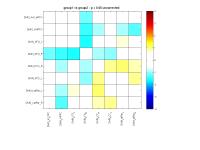 |
Functional connectivity changes in attention-related networks of
childhood leukemia survivors 
Charlotte Sleurs1, Iris Elens2, Jurgen
Lemiere1, Thibo Billiet3, Dorothée
Vercruysse4, Patricia Bijttebier5,
Marina Danckaerts2, Rudi D'Hooghe6,
Ron Peeters3, Stefan Sunaert3, Anne
Uyttebroeck1, Stefaan Van Gool7, and
Sabine Deprez3
1Pediatric Hemato-Oncology, UZ Leuven, Leuven,
Belgium, 2Child
and Adolescent Psychiatry, UZ Leuven, Leuven, Belgium, 3Radiology,
UZ Leuven, Leuven, Belgium, 4Gynaecological
Oncology, UZ Leuven, Leuven, Belgium, 5School
Psychology and Child and Adolescent Development, KU Leuven,
Leuven, Belgium, 6Biological
Psychology, KU Leuven, Leuven, Belgium, 7Pediatric
Hemato-Oncology, University Hospital, Aachen, Germany
Neurocognitive sequelae in childhood leukemia survivors are
often related to attentional disfunctioning. We investigated
whether altered functional brain connectivity might explain
neurocognitive sequelae in childhood leukemia survivors.
Resting state fMRI was investigated, by using ROI-based
connectivity comparisons as well as dual regression analysis
at whole-brain level. We demonstrated that the Default Mode
Network (DMN) and Inferior Temporal Gyrus, was less
functionally connected in childhood leukemia survivors
compared to controls. This suggests an altered coherence
between activity of the DMN and Fronto-Parietal Network
(FPN). Finally, based on this specific connectivity we could
predict clearly reduced cognitive flexibility of the
patients.
|
|
1698.
 |
Effects of long-duration isoflurane administration on default
mode network of macaque brains 
Chun-Xia Li1 and
Xiaodong Zhang1,2
1Yerkes Imaging Center, Yerkes National Primate
Research Center, Emory University, Atlanta, GA, United
States, 2Division
of Neuropharmacology and Neurologic Diseases, Yerkes
National Primate, Atlanta, GA, United States
Long-duration anesthesia administration could cause
neurocognitive decline in animals and humans. However, the
potential mechanism still remains unclear. In the present
study, the functional connectivity of adult rhesus monkeys
under maintenance dosage of isoflurane (~1 %) for four hours
was examined. The results demonstrate that long-duration
isoflurane exposure resulted in decreased functional
connectivity in posterior cingulate cortex (PCC) dominant
default-mode network (DMN). The MRI findings suggest that
the detrimental effects of isoflurane on brain connectivity
may be associated with the neurocognitive decline observed
in subjects after long-duration administration of
isoflurane.
|
|
1699.
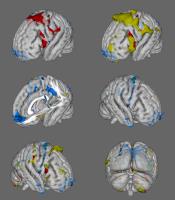 |
Neurofeedback impact onto the brain networks interaction: fMRI
study
Oleksii Omelchenko1 and
Volodymyr Rogozhyn2
1Human and Animal Physiology, Taras Shevchenko
National University of Kyiv, Kyiv, Ukraine, 2Radiology,
Medical Clinic BORIS, Kyiv, Ukraine
Concerning the use of audio-visual stimulation (AVS) as a
component of neurofeedback therapy for neuropsychiatric
disorders we propose to evaluate its effect onto the brain
networks interaction. We performed fMRI before and after the
AVS. fMRI exams showed considerable increase of the volumes
of activation after the AVS and almost complete extinction
of the DMN deactivation. RS fMRI showed functional
connectivity changes after the AVS (connectivity disruption
in visual network, DMN frequency shift). Volume of
activation increase and functional connectivity changes
could be the marker for prolonged effect of AVS brain
stimulation.
|
|
1700.
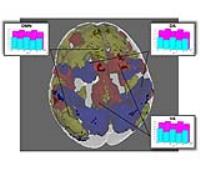 |
Spatial and temporal modulation of brain dynamics in response to
task execution 
Silvia Tommasin1,2, Daniele Mascali1,3,
Tommaso Gili1,2, and Federico Giove1,2
1Enrico Fermi Centre, Rome, Italy, 2Fondazione
Santa Lucia, Roma, Italy, 3Physics,
Università La Sapienza, Roma, Italy
Task-related activity influences brain connectivity through
a two-level pattern modulation both in attentive networks
and in the default mode network. While strengthening the
local homogeneity, task execution reduces regional
synchronization. It produces correlation patterns with
opposite large and small scale properties. Task-related
activity influences also the amplitude of the low frequency
fluctuations in the same networks. The transition from
resting state to steady state task execution, and the way
back, causes a persisting slow drift in this quantity.
|
|
1701.
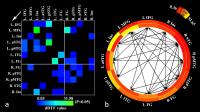 |
Multi-node directed cortical network for speech processing
revealed by multivariate Granger causality analysis
Yayan Yin1, Jiahong Gao1, Bing Wu2,
Yang Fan2, Bingjiang lyu1, and
Jianqiao Ge1
1Peking University, Beijing, China, People's
Republic of, 2GE
Healthcare, Beijing, China, People's Republic of
For decades, how the information flows among multiple brain
regions remains unclear for speech processing, due to the
challenge of mapping multi-node directed cortical pathways
from brain images. In this work, multivariate Granger
causality analysis is employed on functional MR images to
reveal the effective connectivity of Chinese language-speech
network for the first time. The results showed that left
insula and posterior middle temporal gyrus were the strong
driver nodes, the left middle frontal gyrus and superior
temporal gyrus were the most received nodes in the network.
We also found greater interhemispheric connectivity in
females compared to males.
|
|
1702.
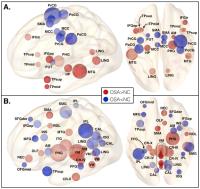 |
Modular Reorganization of Resting-State Brain Network in
Patients with Obstructive Sleep Apnea
Bumhee Park1, Sudhakar Tummala1, Ruchi
Vig1, Daniel W Kang2, Mary A Woo3,
and Rajesh Kumar1,4,5,6
1Anesthesiology, University of California at Los
Angeles, Los Angeles, CA, United States, 2Medicine,
University of California at Los Angeles, Los Angeles, CA,
United States, 3UCLA
School of Nursing, Los Angeles, CA, United States, 4Radiological
Sciences, University of California at Los Angeles, Los
Angeles, CA, United States, 5Bioengineering,
University of California at Los Angeles, Los Angeles, CA,
United States, 6Brain
Research Institute, University of California at Los Angeles,
Los Angeles, CA, United States
Obstructive sleep apnea (OSA) condition is accompanied by
brain tissue injury and functional deficits in regions
serving autonomic, neuropsychologic, and cognitive
functions. Brain networks are organized into modular systems
and assigning vulnerable role for each region in terms of
intra- and inter-modular communication provides better
understanding for functional deficits in the condition. We
examined the modular reorganization of OSA functional
networks, and found abnormal intra- and/or inter-modular
communication roles in brain regions involved in autonomic,
neuropsychologic, and cognitive regulation. The findings
suggest that dysfunctions associated with OSA may be related
to abnormal information flow, and can be examined with
modular reorganization assessment.
|
|
1703.
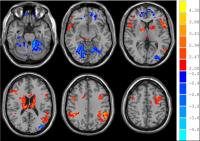 |
Bilateral amygdaloid functional connectivity in chronic
alcoholics 
Ylin Zhao1, Jun Chen2, and Hui Lin3
1Radiology, Renmin Hospital of Wuhan University,
Wuhan, China, People's Republic of, 2Renmin
Hospital of Wuhan University, Wuhan, China, People's
Republic of, 3Healthcare,MR
Research China, Beijing, China, People's Republic of
FC-MRI is a useful tool for examining functional
relationships between the bilateral amygdaloid and whole
brain regions. The functional coordination of bilateral
amygdala and cerebral cortex was enhanced,and the functional
coordination of bilateral amygdala and cerebellum was
weakened.Amygdala may be involved in regulating the function
of fronto-cerebellar loops.Thus, this method shows promise
as a tool for in vivo investigations of the functioning of
human fronto-cerebellar circuitry. It is our hope that in
future studies this technique may provide the opportunity to
examine the integrity of networks involving the brain
cerebellum inpatient groups with chronic alcoholics, a major
goal of our research.
|
|
1704.
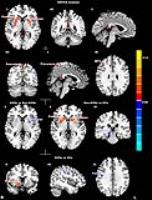 |
Putamen-related regional and network functional deficits in
first-episode schizophrenia with auditory verbal hallucinations
Long-Biao Cui1, Yi-Bin Xi1, and Hong
Yin1
1Xijing Hospital, Fourth Mililtary Medical
University, Xi'an, China, People's Republic of
Our results suggest an association of abnormal regional
function in the putamen and prefrontal cortex and
hyperconnectivity between them with AVHs in SZ. The
functional interaction of the putamen with DLPFC and Broca’s
area seems to be crucial for AVHs in SZ. Additionally, the
putamen-related regional and network functional deficits may
also serve as a potential diagnostic biomarker of AVHs in SZ
based on the direct evidence in vivo we found. In SZ
patients, there is an extensive hypoconnectivity within
cortical-striatal-cerebellar networks, which further
supports the current thinking about disconnection hypothesis
of SZ.
|
|
1705.
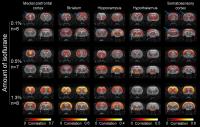 |
Light isoflurane sedation: an excellent trade-off between
anesthesia and awake condition in functional connectivity
studies with rats
Jaakko Paasonen1, Raimo A Salo1, Artem
Shatillo2, and Olli Gröhn1
1Department of Neurobiology, University of
Eastern Finland, Kuopio, Finland, 2Charles
River Discovery Services, Kuopio, Finland
Prevention of motion is a prerequisite for preclinical
functional connectivity (FC) studies. However, anesthesia
alters brain function, and awake protocols may induce
stress. Therefore, we investigated the feasibility of using
light sedation in FC studies. FC was estimated under
0.1/0.5% isoflurane (subanesthetic doses) with acclimatized
rats, and under 1.3% isoflurane (anesthetic dose). Results
demonstrate different FC between anesthetic and
subanesthetic doses. The physiologic measures suggest, that
the 0.5% rats adapted well to imaging, while the 0.1% rats
did so insufficiently. Therefore, light isoflurane sedation
may provide an excellent combination for FC investigations:
minimal stress and motion with normal brain function.
|
|
1706.
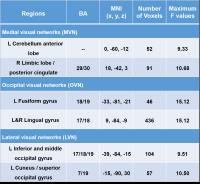 |
Visual Networks Impairments in Minimal Hepatic Encephalopathy
Using Resting-State fMRI
Yun Jiao1, Xun-Heng Wang2, and
Tian-Yun Tang1
1Jiangsu Key Laboratory of Molecular and
Functional Imaging, Department of Radiology, Zhongda
Hospital, Medical school of Southeast University, Nanjing,
China, People's Republic of, 2College
of Life Information Science and Instrument Engineering,
Hangzhou Dianzi University, Hangzhou, China, People's
Republic of
We applied dual regression to investigated functional
connectivity impairments within visual networks for minimal
hepatic encephalopathy (MHE) patients’ brain. Functional
deficits within occipital and lateral visual networks
(visual area V2 and V3) were endogenous, and significantly
association with neurocognitive impairments. This maybe the
reason for the compensatory enhancements within medial
visual network (visual area V1) which indicated that
patients with MHE had the potential to additionally recruit
more neurological resource to process the spatial
information from visual areas V2 and V3. Our results
demonstrated the possible mechanisms for deficits in visual
perception, visuo-spatial orientation, and visuo-constructive
abilities in MHE patients
|
|
1707.
 |
Acupuncture Stimulation changes DMN functional conectivity. 
Tomokazu Murase1, Masahiro Umeda1,
Masaki Fukunaga2, Katsuya Maruyama3,
Yuko Kawai1, Yasuharu Watanabe1, and
Toshihiro Higuchi4
1Medical Informatics, Meiji University of
Integrative Medicine, Nantan-shi, Japan, 2Cerebral
Integration, National Institute for Physiological Sciences,
Okazaki-shi, Japan, 3Research&Collaboration,
Siemens Japan, Shinagawa-ku, Japan, 4Neurosurgery,
Meiji University of Integrative Medicine, Nantan-shi, Japan
Clinical studies have shown that acupuncture relieves
different kinds of pain. However, the effectiveness of these
methods is unclear. We used rs-fMRI and FC analysis to
examine the RSN activity before and after acupuncture
stimulation. In the result, DMN was changed with or without
manual acupuncture. The acupuncture stimulation controls a
pain by modifying mechanism of pain transmission.
|
|
1708.
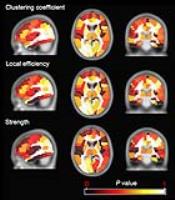 |
Intrinsic functional connectivity in patients with presbycusis
Fei Gao1, Guangbin Wang1, Bin Zhao1,
Muwei Li2, Fuxin Ren1, and Weibo Chen3
1Shandong Medical Imaging Research Institute,
Shandong University, JINAN, China, People's Republic of, 2College
of Electronics and Information Engineering, Sichuan
University, Chengdu, China, People's Republic of, 3Philips
Healthcare, Shanghai, China, People's Republic of
Presbycusis is the most common sensory deficit in the ageing
population. However, little is known about whether the
topological properties of brain functional networks is
disrupted in patients with presbycusis. Our study
demonstrates decreased clustering coefficient, local
efficiency and strength in the primary auditory cortex in
patients with presbycusis, as compared to age- and
gender-matched healthy controls. Our study provides evidence
of presbycusis-related disruptions in brain functional
networks in patients with presbycusis. It is believed that
our findings could be important for exploring functional
changes in the central presbycusis.
|
|
1709.
 |
Altered small world brain function network in patients of lower
back pain
Jing Liu1, Xiufen Liu2, zhizheng Zhuo3,
Juan Wei4, Queenie Chan5, and Xiaoying
Wang1
1Radiology, Peking University First Hospital,
Beijing, China, People's Republic of, 2Anesthesiology,
Peking University First Hospital, Beijing, China, People's
Republic of, 3Philips
Healthcare Beijing China, Beijing, China, People's Republic
of, 4Philips
Research China, Shanghai, China, Shanghai, China, People's
Republic of, 5Philips
Healthcare, China, Hongkong, China, People's Republic of
An altered functional network was found in the brain of LP
here represents a less optimal network organization in the
LP. It has been suggested that the small-world structure
reflects an optimal balance between local processing and
global integration. And the small-world structure of LP
brain networks maybe destroyed due to the chronic LP.
|
|
1710.
|
Subregion-specific Resting-State Amygdala Connectivity in
Chronic Knee Osteoarthritis Pain: Towards a brain network
signature of OA pain
William J Cottam1,2,3, Marianne Drabek1,2,3,
Diane Reckziegel1,2,3, and Dorothee P Auer1,2,3
1Division of Clinical Neuroscience, Radiological
Sciences, University of Nottingham, Nottingham, United
Kingdom, 2ARUK
Pain Centre, University of Nottingham, Nottingham, United
Kingdom, 3Sir
Peter Mansfield Imaging Centre, University of Nottingham,
Nottingham, United Kingdom
Brain network connectivity analysis arguably offers the most
sensitive marker to detect dysfunctional brain plasticity
underlying the maladaptive nature of chronic pain. Early
functional connectivity (fc) studies reveal altered
functional connectivity in chronic pain states, but to the
best of our knowledge no studies have focussed upon the
amygdala. We aimed to investigate whether patients with
painful chronic knee OA show altered amygdala connectivity
compared to pain-free controls.This study identified
increased functional connectivity of specific amygdala
subnuclei in chronic OA pain patients compared to healthy
subjects.
|
|
1711.
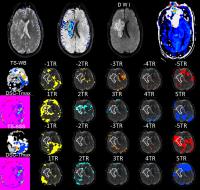 |
Time-shift functional connectivity MRI based on specific
regional-of-interest for mapping acute ischemic Stroke 
xiaokun fang1, qiang xu2, yong zhang3,
zhiqiang zhang1, and guangming lu1
1Medical Imaging, Jingling Hospital, School of
Medicine, Nanjing University, Nanjing, Jiangsu, China,
nanjing, China, People's Republic of, 2Medical
Imaging, Jingling Hospital, School of Medicine, Nanjing,
nanjing, China, People's Republic of, 3MR
Research China, GE Healthcare, beijing, China, People's
Republic of
To investigate if Time-shift functional connectivity based
resting-state fMRI can be used to create maps similar to
time-to-maximum of (Tmax) in acute stroke and to determine
whether Maps obtained with the SSS seed (superior saggital
sinus) or whole brain as the seed in Time-shift functional
connectivity based resting-state fMRI be better in mapping
the acute stroke.
|
|
1712.
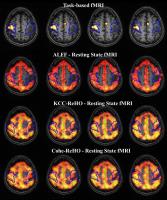 |
Demonstration of brain tumor-induced abnormalities on regional
homogeneity (ReHo) resting state fMRI metrics KCC-ReHo &
Cohe-ReHo 
Shruti Agarwal1, Noushin Yahyavi-Firouz-Abadi1,
Haris I. Sair1, Raag Airan1, and Jay
J. Pillai1
1Division of Neuroradiology, Russell H. Morgan
Department of Radiology and Radiological Science, Johns
Hopkins University School of Medicine, Baltimore, MD, United
States
Disruption of the normal coupling between neural activity
and the consequent microvascular blood flow response
(neurovascular uncoupling or NVU) may severely compromise
the validity of BOLD fMRI in presurgical planning. The
effects of brain tumor-related NVU on resting state BOLD
fMRI (rsfMRI) using functional connectivity analysis have
been previously published. In this study we evaluated
regional homogeneity (ReHo) of rsfMRI data based on
Kendall's coefficient of concordance (KCC-ReHo) & Coherence
(Cohe-ReHo) and compared the results with the amplitude of
low-frequency fluctuation (ALFF) & standard motor tbfMRI
activation to investigate regional abnormalities due to
brain tumor-induced NVU in sensorimotor network.
|
|
